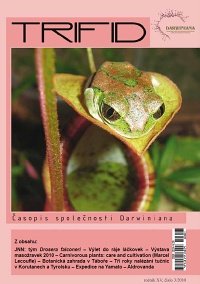Trifid 2010/3
Visit to the Kozlovice locality
Tomáš Both
Carnivorous plants also grow in the Czech Republic, that's why you can find a short article about a trip to this Czech locality. You'll learn the differences in conditions between each place of this meadow and the response of plants to it.
How to Grow – team Drosera falconeri
Jiří Vaněk
This team was affected by a really high death rate. Only the leader was able to keep 2/3 of plants healthy. Read about the results of the experiment, descriptions of the places where the plants were grown, substrates used and the difficulties caused by the dormancy of plants, etc.
Trip to Nepenthes paradise - Borneo 2009, part III
Václav Kubín
Right at the beginning of the third episode of the story from the journey through Borneo the author mentions a locality, where it is possible to find seven Nepenthes species. Also visit to a cave colonized by 7 million bats was definitely an unusual experience.
During the next three-day trip the author is going to climb one thousand meters higher, find a few carnivorous species and meet wild wasps and numbers of hungry leeches.
What happened after arriving at the Hot-Springs – an oasis in the middle of the forest – to be continued…
Exhibition 2010
Jana Rubešová
A short description of the work before the exhibition was opened. There are also some interesting facts and brief statistics of attendees.
Marcel Lecoufle: Carnivorous plants – care and cultivation
Adam Veleba
Review of one of our old books, that is on offer in our Library. Three parts focused on basic information, types of traps and of course number of photos. You can find brief tables there and the most favourite prey of each species.
Tábor botanic garden
Radoslav Kacerovský
Learn what the botanic garden has done and come through in its approximately 150year history. You can also find information about each part of garden, names of grown species and calendar of future events.
Three Pinguicula years in Carinthia and Tyrol
Albert Damaška
Albert writes about a few interesting Pinguicula localities in Austria and Italy. There is also information about orchids and other interesting species, not only plants.
Expedition for carnivorous plants at Yamato, Part I
Sebastian Vieira
You can read basic information about the description of locality and a number of photographs with brief descriptions of plants from the bladderwort genus (Utricularia).
Utricularia bremii in brief
Adam Veleba
The strong resemblance between U. bremii and U. minor was probably the main reason of their constant mistaken identity. It possibly leads to an actual rediscovery of U. bremii populations on locations where it was considered to have disappeared.
Aldrovanda – microscopic trip to word of unusual water carnivorous plant
Karol Gazdík
Read an interesting article with lots of drawings and photos interested in this rare water species. The author also mentions differences from its relative plant – Dionaea muscipula.
